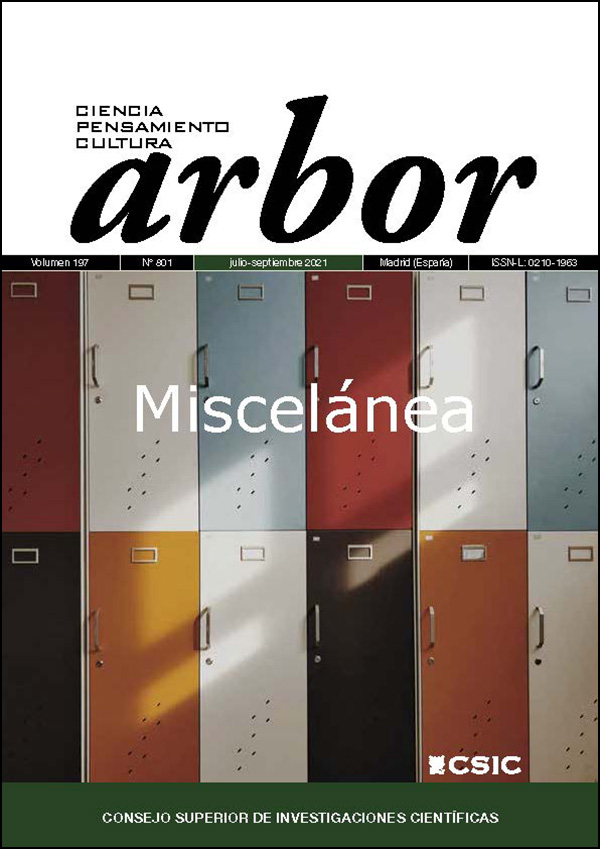Theatrical illusion. Construction from the writing perspective
DOI:
https://doi.org/10.3989/arbor.2021.801002Keywords:
Illusion, word, image, literary theater, visual theater, current theater, Eastern theaterAbstract
This article reflects the state of the art of the conceptual, formal, linguistic and sociopolitical correspondences of the filmic / audiovisual essay with respect to the canons of the literary essay. It summarizes the essential theoretical contributions in both fields. The exploration deciphers how some basic patterns remain identical as they share the same root in the experience reflected by the subject, but their translation to the audiovisual medium, while maintaining an undeniable coexistence of equivalences, accounts for linguistic differences related to the properties of a complex device, which is also decisive for a greater or lesser demonstration of some given traits. Although new technologies raise the value of the manifestation of subjectivity, there is a lack of studies oriented towards their influence on the construction of the essay text and its social effects. As a result of this gap, the canonical references to analyze the relationships between both manifestations appear to not contemplate experiences of peripheral cinematographies or to delve more deeply into experimental practices that would provide an answer to the above.
Downloads
References
Álvarez Romero, María (2015). La escenografía del pensamiento [Trabajo de Fin de Grado inédito]. Universidad de Sevilla: Sevilla.
Baudrillard, Jean (2006). El complot del arte. Ilusión y desilusión estéticas. Buenos Aires: Amorrortu.
Bologna, Corrado (2017). El teatro de la mente. De Giulio Camillo a Aby Warburg. Madrid: Siruela.
Campioni, Giuliano (2007). Fisiología de la ilusión y de la décadence: el problema del actor y del teatro en Nietzsche y Wagner. Estudios Nietzsche, 7, pp. 37-54. https://doi.org/10.24310/EstudiosNIETen.vi7.10268
Fabre, Jan (2017). Diario nocturno (1978-1984). Madrid: Casimiro Libros.
Fischer-Lichte, Erika (2011). Estética de lo performativo. Madrid: Abada.
Gil Fernández, Luis (2012). Aristófanes. Madrid: Gredos.
Gombrich, Ernst H. (2008). Arte e ilusión. Estudio sobre la psicología de la representación pictórica. New York: Phaidon.
González, Aurelio (2007). Ilusión y engaño en el teatro cervantino. En Germán Vega García-Luengos y Rafael González Cañal (eds.). Locos, figurones y quijotes en el teatro de los Siglos de Oro: Actas selectas del XII Congreso de la Asociación Internacional de Teatro Español y Novohispano de los Siglos de Oro. Ciudad Real: Ediciones de la Universidad de Castilla-La Mancha. pp. 207-219.
Jingsong, Chen (1997). To Make People Happy, Drama Imitates Joy: The Chinese Theatrical Concept of Mo. Asian Theater Journal, 14 (1), pp. 38-55. https://doi.org/10.2307/1124084
Kantor, Tadeusz (2010). Teatro de la muerte y otros ensayos (1944-1986). Barcelona: Alba.
Martínez Luna, Sergio (2016). La cultura visual contemporánea y la cuestión de la materialidad. Imágenes, mediaciones, figuralidad. Escritura e imagen, 12, pp. 93-111. https://doi.org/10.5209/ESIM.54032
Nieto Nuño, Miguel (1998). Teatro y cine: Esquilache. En Natividad Cristina Carreras Lario y Celia Crespo Gámez (coords.). Cien años de cine: la fábrica y los sueños. Sevilla: Universidad de Sevilla, pp. 311-321.
Ortolani, Benito (1995). The Japanese theater. From shamanistic ritual to contemporary pluralism. Princeton: Princeton University Press.
Parmeggiani, Marco (2003). El concepto de ilusión en Schopenhauer y Nietzsche. Estudios Nietzsche, 3, pp. 43-66. https://doi.org/10.24310/EstudiosNIETen.vi3.9109
Prévand, Jean-François (2018). Voltaire / Rousseau: la disputa. Lleida: Milenio Publicaciones.
Teixeira de Souza, Ana Aparecida (2018). El fingimiento de la identidad y la ilusión teatral en Los baños de Argel de Cervantes. Hipogrifo. Revista de literatura y cultura del Siglo de Oro, 6 (1), pp. 205-215. https://doi.org/10.13035/H.2018.06.01.15
Valiente, Pedro (2000). Estudio del proceso de creación de la obra de Robert Wilson [Tesis doctoral inédita]. Universidad Complutense de Madrid: Madrid.
Wang Shifu (2002). Historia del ala oeste. En Alicia Relinque Eleta (ed. y trad.). Tres dramas chinos. Madrid: Gredos.
Published
How to Cite
Issue
Section
License
Copyright (c) 2021 Consejo Superior de Investigaciones Científicas (CSIC)

This work is licensed under a Creative Commons Attribution 4.0 International License.
© CSIC. Manuscripts published in both the printed and online versions of this Journal are the property of Consejo Superior de Investigaciones Científicas, and quoting this source is a requirement for any partial or full reproduction.All contents of this electronic edition, except where otherwise noted, are distributed under a “Creative Commons Attribution 4.0 International” (CC BY 4.0) License. You may read here the basic information and the legal text of the license. The indication of the CC BY 4.0 License must be expressly stated in this way when necessary.
Self-archiving in repositories, personal webpages or similar, of any version other than the published by the Editor, is not allowed.















